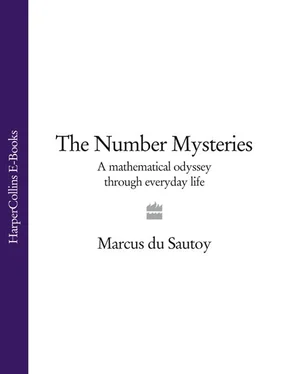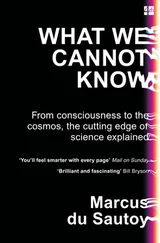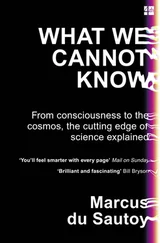The table below shows the changes in probability:
Primes get rarer and rarer, but they get rarer in a very regular way. Every time I add a digit, the probability decreases by about the same amount, 2.3, each time. The first person to notice this was a fifteen-year-old boy. His name was Carl Friedrich Gauss (1777–1855), and he would go on to become one of the greatest names in mathematics.
TABLE 1.2
Gauss made his discovery after being given a book of mathematical tables for his birthday which contained in the back a table of prime numbers. He was so obsessed with these numbers that he spent the rest of his life adding more and more figures to the tables in his spare time. Gauss was an experimental mathematician who liked to play around with data, and he believed that the way the primes thinned out would carry on in this uniform way however far you counted through the universe of numbers.
But how can you be sure that something strange won’t suddenly happen when you hit 100-digit numbers, or 1,000,000-digit numbers? Would the probability still be the same as adding on 2.3 for each new digit, or could the probabilities suddenly start behaving totally differently? Gauss believed that the pattern would always be there, but it took until 1896 for him to be vindicated. Two mathematicians, Jacques Hadamard and Charles de la Vallée Poussin, independently proved what is now called the prime number theorem: that the primes will always thin out in this uniform way.
Gauss’s discovery has led to a very powerful model which helps to predict a lot about the behaviour of prime numbers. It’s as if, to choose the primes, nature used a set of prime number dice with all sides blank except for one with a PRIME written on it:
FIGURE 1.25 Nature’s prime number dice.
To decide whether each number is going to be prime, roll the dice. If it lands prime side up, then mark that number as prime; if it’s blank side up, the number isn’t prime. Of course, this is just a heuristic model—you can’t make 100 indivisible just by a roll of the dice. But it will give a set of numbers whose distribution is believed to be very like that of the primes. Gauss’s prime number theorem tells us how many sides there are on the dice. So for three-digit numbers, use a six-sided dice or a cube with one side prime. For four-digit numbers, an eight-sided dice—an octahedron. For five, digits a dice with 10.4 sides … of course, these are theoretical dice because there isn’t a polyhedron with 10.4 sides.
What’s the million-dollar prime problem?
The million-dollar question is about the nature of these dice: are the dice fair or not? Are the dice distributing the primes fairly through the universe of numbers, or are there regions where they are biased, sometimes giving too many primes, sometimes too few? The name of this problem is the Riemann Hypothesis.
Bernhard Riemann was a student of Gauss’s in the German city of Göttingen. He developed some very sophisticated mathematics which allows us to understand how these prime number dice are distributing the primes. Using something called a zeta function, special numbers called imaginary numbers and a fearsome amount of analysis, Riemann worked out the mathematics that controls the fall of these dice. He believed from his analysis that the dice would be fair, but he couldn’t prove it. To prove the Riemann Hypothesis, that is what you have to do.
Another way to interpret the Riemann Hypothesis is to compare the prime numbers to molecules of gas in a room. You may not know at any one instance where each molecule is, but the physics says that the molecules will be fairly evenly distributed around the room. There won’t be one corner with a concentration of molecules, and at another corner a complete vacuum. The Riemann Hypothesis would have the same implication for the primes. It doesn’t really help us to say where each particular prime can be found, but it does guarantee that they are distributed in a fair but random way through the universe of numbers. That kind of guarantee is often enough for mathematicians to be able to navigate the universe of numbers with a sufficient degree of confidence. However, until the million dollars is won, we’ll never be certain quite what the primes are doing as we count our way further into the never-ending reaches of the mathematical cosmos.
TWO
The Story of the Elusive Shape
The great seventeenth-century scientist Galileo Galilei once wrote:
The universe cannot be read until we have learnt the language and become familiar with the characters in which it is written. It is written in mathematical language, and the letters are triangles, circles and other geometrical figures, without which means it is humanly impossible to comprehend a single word. Without these, one is wandering about in a dark labyrinth.
This chapter presents the A–Z of nature’s weird and wonderful shapes: from the six-pointed snowflake to the spiral of DNA, from the radial symmetry of a diamond to the complex shape of a leaf. Why are bubbles perfectly spherical? How does the body make such hugely complex shapes like the human lung? What shape is our universe? Mathematics is at the heart of understanding how and why nature makes such a variety of shapes, and it also gives us the power to create new shapes as well as the ability to say when there are no more shapes to be discovered.
It isn’t only mathematicians who are interested in shapes: architects, engineers, scientists and artists all want to understand how nature’s shapes work. They all rely on the mathematics of geometry. The Ancient Greek philosopher Plato put above his door a sign declaring: ‘Let no one ignorant of geometry enter here.’ In this chapter I want to give you a passport to Plato’s home, to the mathematical world of shapes. And at the end I’ll reveal another mathematical puzzle, one whose solution is worth another million dollars.
Why are bubbles spherical?
Take a piece of wire and bend it into a square. Dip it in bubble mixture and blow. Why isn’t it a cube-shaped bubble that comes out the other side? Or if the wire is triangular, why can’t you blow a pyramid-shaped bubble? Why is it that, regardless of the shape of the frame, the bubble comes out as a perfect spherical ball? The answer is that nature is lazy, and the sphere is nature’s easiest shape. The bubble tries to find the shape that uses the least amount of energy, and that energy is proportional to the surface area. The bubble contains a fixed volume of air, and that volume does not change if the shape changes. The sphere is the shape that has the smallest surface area which can contain that fixed amount of air. That makes it the shape that uses the least amount of energy.
Manufacturers have long been keen to copy nature’s ability to make perfect spheres. If you’re making ball bearings or shot for guns, getting perfect spheres could be a matter of life and death, since a slight imperfection in the spherical shape could lead to a gun backfiring or a machine breaking down. The breakthrough came in 1783 when a Bristol-born plumber, William Watts, realized that he could exploit nature’s predilection for spheres.
When molten iron is dropped from the top of a tall tower, like the bubble the liquid droplets form into perfect spheres during their descent. Watts wondered whether, if you stuck a vat of water at the bottom of the tower, you could freeze the spherical shapes as the droplets of iron hit the water. He decided to try his idea out in his own house in Bristol. The trouble was that he needed the drop to be further than three floors to give the falling molten lead time to form into spherical droplets.
So Watts added another three storeys on top of his house and cut holes in all the floors to allow the lead to fall through the building. The neighbours were a bit shocked by the sudden appearance of this tower on the top of his home, despite his attempts to give it a Gothic twist with the addition of some castlelike trim around the top. But so successful were Watts’s experiments that similar towers soon shot up across England and America. His own shot tower stayed in operation until 1968.
Читать дальше












